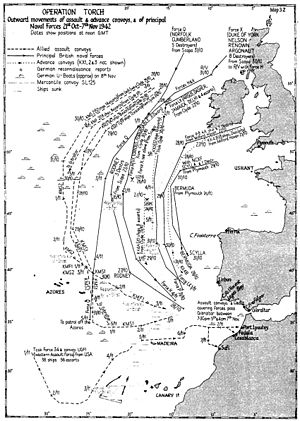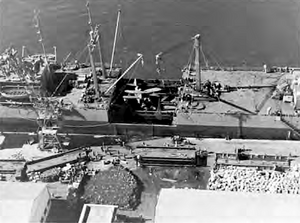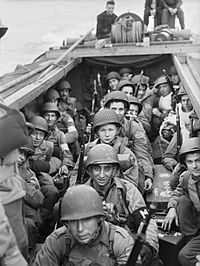Operation Torch facts for kids
Quick facts for kids Operation Torch |
|||||||||
|---|---|---|---|---|---|---|---|---|---|
| Part of the North African campaign of the Second World war | |||||||||
 Landings during the operation |
|||||||||
|
|||||||||
| Belligerents | |||||||||
|
|
|
||||||||
| Commanders and leaders | |||||||||
|
|
||||||||
| Strength | |||||||||
| Ground forces: 107,000 troops 35,000 in Morocco 39,000 near Algiers 33,000 near Oran Naval activity: 350 warships 500 transports Total: 850 |
Ground forces: 125,000 troops 210 tanks 500 aircraft many shore batteries and artillery pieces Naval activity: 1 battleship (partially armed) 10 other warships 11 submarines Germany: 14 submarines Italy: 14 submarines |
||||||||
| Casualties and losses | |||||||||
| United States: 526 dead United Kingdom: 574 dead All Other Allies: 756 total wounded 1 escort carrier (HMS Avenger) sunk with loss of 516 men 4 destroyers lost 2 sloops lost 6 troopships lost 1 minesweeper lost 1 auxiliary anti-aircraft ship lost |
Vichy France: 1,346+ dead 1,997 wounded several shore batteries destroyed all artillery pieces captured 1 light cruiser lost 5 destroyers lost 6 submarines lost 2 flotilla leaders lost Germany: 8 submarines lost by 17 November Italy: 2 submarines lost by 17 November |
||||||||
Operation Torch was a big invasion by the Allied forces during World War II. It happened from November 8 to November 16, 1942. The goal was to invade French North Africa, which included Morocco and Algeria. This operation was a way for the British to gain control in North Africa. It also allowed American troops to fight against Nazi Germany on a smaller scale. It was the first time many U.S. soldiers fought in the war's European-North African area. It also saw the first major airborne assault by the United States.
Even though the French colonies were officially on Germany's side through Vichy France, many people there had mixed feelings. Some reports said they might support the Allies. American General Dwight D. Eisenhower, who was the top commander for the Allies, planned a three-part attack. They would attack Casablanca (west), Oran (center), and Algiers (east). Then, they would quickly move towards Tunis. The idea was to trap the German and Italian forces (Afrika Korps) in North Africa. This would happen as the Allies also advanced from Egypt.
The Western Task Force, which landed in Casablanca, faced unexpected fighting and bad weather. But Casablanca, a main French naval base, was captured after a short fight. The Center Task Force had some ships damaged when they tried to land in shallow water. However, the French ships were sunk or forced away. Oran surrendered after British battleships attacked it. In Algiers, the French Resistance successfully tried to take control. Even with a late warning to the Vichy forces, the Eastern Task Force faced less resistance. They were able to move inland and force a surrender on the first day.
Because Torch was successful, Admiral François Darlan, the commander of Vichy French forces, ordered his troops to work with the Allies. In return, he was made High Commissioner, and many other Vichy officials kept their jobs. Darlan was killed soon after. Then, the Free French group slowly took over the government.
Contents
Why the Allies Invaded North Africa
The Allies planned for American and British forces to invade French North Africa. This area included Morocco, Algeria, and Tunisia. These lands were controlled by the Vichy French government. British forces were already moving forward from Egypt. So, this invasion would allow the Allies to trap the German and Italian forces in North Africa. This kind of attack is called a pincer movement.
The Vichy French had about 125,000 soldiers in these areas. They also had coastal guns, 210 old tanks, and about 500 airplanes. Half of these planes were Dewoitine D.520 fighters, which were as good as many British and U.S. fighters. There were also about 10 warships and 11 submarines at Casablanca.
The Political Situation
The Allies thought the Vichy French army would not fight them. This was partly because of information from American Consul Robert Daniel Murphy in Algiers. The French had been Allies before, and American troops were told not to shoot first.
However, the Allies worried that the Vichy French Navy might still be angry. In June 1940, the British attacked French ships at Mers-el-Kébir, near Oran. This was to stop the Germans from taking the ships. Almost 1,300 French sailors died in that attack.
It was important to know how the French forces in North Africa felt. Plans were made to get them to cooperate instead of fighting. Germany helped the Vichy French with air support. German Luftwaffe bomber planes attacked Allied ports in Algiers and along the North African coast.
Who Was in Charge
General Dwight D. Eisenhower was put in charge of Operation Torch. He set up his main office in Gibraltar. Admiral Sir Andrew Cunningham was the top naval commander. His deputy, Vice-Admiral Sir Bertram Ramsay, planned the landings from the sea.
Debate Among Allied Leaders
Some top U.S. commanders did not want this invasion. Generals like George Marshall wanted to invade northern Europe instead. But the British did not agree with that plan. British Prime Minister Winston Churchill pushed for the North Africa landing in 1942. President Franklin D. Roosevelt then ordered that Torch should happen as soon as possible. This was one of only two direct orders he gave to military commanders during the war.
The Allies also had to think about the complicated political situation in North Africa. The Americans recognized the Vichy government, but the British did not. The British supported General Charles de Gaulle's French National Committee, which was like a government-in-exile. North Africa was part of France's colonies and was supposed to support Vichy. But not everyone there agreed with that.
The French people in North Africa were divided into three main groups:
- Gaullists: These people supported Charles de Gaulle. They were French refugees who escaped France to avoid German occupation. Or they were people who stayed and joined the French Resistance.
- French Liberation Movement: Some French people in North Africa secretly worked to free France. General Henri Giraud, who had just escaped from Germany, later led this group.
- Loyal Pro-Vichy French: These people stayed loyal to Marshal Philippe Pétain. They believed working with Germany was best for France. François Darlan was Pétain's chosen successor.
American planners had to consider these groups. They hoped that if Allied military support was given, these leaders would work to free themselves. The U.S. had secret talks with the French Liberation Movement. Because of the divided loyalties and the need for secrecy, detailed plans could not be shared with the French.
Allied Plans for Attack
Planners chose Oran, Algiers, and Casablanca as the main targets. They also wanted to land at Tunis to secure Tunisia. This would help stop supplies from reaching German General Erwin Rommel's forces in Libya. But Tunis was too close to German airfields in Sicily and Sardinia. So, landing there would be too risky.
A compromise was to land at Bône in eastern Algeria. This was about 300 miles closer to Tunis than Algiers. But the Allies had limited resources. Eisenhower wanted to land at Oran and Algiers. He had two main choices:
- Western Option: Land at Casablanca, Oran, and Algiers. Then, quickly move to Tunis.
- Eastern Option: Land at Oran, Algiers, and Bône. Then, move overland to Casablanca.
Eisenhower liked the eastern option because it would help capture Tunis sooner. Also, the Atlantic waves off Casablanca made sea landings much riskier than in the Mediterranean.
However, the top Allied military leaders worried about Spain. They feared Spain might join Germany and close the Strait of Gibraltar. This would cut off the Allied forces' supply lines. So, they chose the Casablanca option. This was seen as less risky because forces in Algeria and Tunisia could get supplies from Casablanca, even if it was difficult.
General Marshall's opposition to Torch delayed the landings by almost a month. He also opposed landings in Algeria. This made British military leaders question his plans. The British Navy controlled the Strait of Gibraltar, and Spain was unlikely to get involved. The landings in Morocco meant Tunisia could not be taken quickly.
Gathering Information
In July 1941, Mieczysław Zygfryd Słowikowski (code name "Rygor") created "Agency Africa". This was one of the most successful spy groups of World War II. The information they gathered helped the Americans and British plan the November 1942 Operation Torch landings in North Africa.
Talking to Vichy French Leaders
To understand how the Vichy French forces felt, Robert Murphy was sent to the American consulate in Algeria. His secret job was to find out the mood of the French forces. He also needed to contact people who might support an Allied invasion. He met several French officers, including General Charles Mast, the French commander in Algiers.
These officers wanted to help the Allies. They asked for a secret meeting with a senior Allied General in Algeria. Major General Mark W. Clark, one of Eisenhower's top commanders, met with these Vichy French officers on October 21, 1942. The meeting happened in Cherchell, Algeria, after he arrived by British submarine.
With help from the French Resistance, the Allies also secretly brought French General Henri Giraud out of Vichy France. He was taken to Gibraltar, where Eisenhower had his headquarters. The Allies wanted to offer Giraud the job of commander-in-chief of French forces in North Africa after the invasion. But Giraud would only accept being the commander-in-chief of all the invading forces, a job already given to Eisenhower. When he was refused, he decided to just "watch what happened."
The Battle Begins
The Allies created three groups to land from the sea. They would attack key ports and airports in Morocco and Algeria at the same time. Their targets were Casablanca, Oran, and Algiers. After these were captured, they planned to move east into Tunisia.
The Western Task Force went to Casablanca. It was made up of American units. Major General George S. Patton was in charge of the soldiers, and Rear Admiral Henry Kent Hewitt led the naval operations. This force had 35,000 troops on over 100 ships. They traveled directly from the United States.
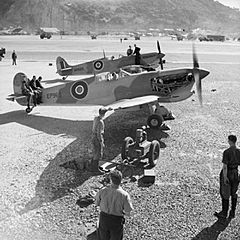
The Center Task Force went to Oran. It had 18,500 troops. They sailed from the United Kingdom. Major General Lloyd Fredendall commanded the soldiers.
For propaganda, the invasion was presented as a U.S. landing. This was because the Allies thought French people would prefer an American invasion over a British one. For the same reason, some British soldiers even wore U.S. Army uniforms. British planes used U.S. "star" symbols, and two British destroyers flew the American flag.
The Eastern Task Force went to Algiers. It was commanded by Lieutenant-General Kenneth Anderson. It had 20,000 troops, including British and U.S. soldiers. During the landing, U.S. Major General Charles W. Ryder led the ground forces. Royal Navy Vice-Admiral Sir Harold Burrough led the naval forces.
German submarines in the Atlantic were busy attacking other trade ships. This meant they were not in the way of the invasion convoys.
Air operations were split into two commands. British Royal Air Force planes operated east of Cape Tenez in Algeria. All United States Army Air Forces planes operated west of Cape Tenez. They were led by Major General Jimmy Doolittle.
Fighting in Casablanca
The Western Task Force landed before sunrise on November 8, 1942. They landed at three places in Morocco: Safi, Fedala, and Mehdiya-Port Lyautey. The Allies hoped the French would not fight, so they did not bomb the areas first. This turned out to be a mistake, as French defenses caused problems for the American landing forces.
On the night of November 7, a pro-Allied French General named Antoine Béthouart tried to take control from the French command in Morocco. He wanted to surrender to the Allies the next day. His forces surrounded the home of General Charles Noguès, who was loyal to Vichy. But Noguès called loyal forces, who stopped the takeover. This attempt also warned Noguès about the coming Allied invasion, and he quickly made French coastal defenses stronger.
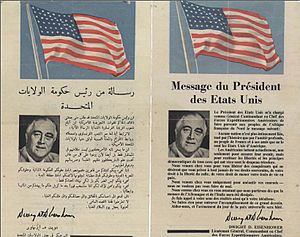
At Fedala, a small port near Casablanca, bad weather made landings difficult. French guns fired on the landing beaches after sunrise. Patton landed at 8:00 AM, and the beach areas were secured later that day. The Americans surrounded Casablanca by November 10. The city surrendered an hour before the final attack was supposed to happen.
Casablanca was the main French Atlantic naval base after Germany took over the European coast. The Naval Battle of Casablanca happened when French ships tried to stop the landings. An American battleship, USS Massachusetts, fired its large guns at the French battleship Jean Bart, which was docked and could not move. The Jean Bart was damaged and could no longer fire. Many French ships, including a cruiser, six destroyers, and six submarines, were destroyed by American gunfire and planes. Two U.S. destroyers were also damaged.
At Safi, the goal was to capture the port to land the Western Task Force's tanks. The landings were mostly successful. They started without covering fire, hoping the French would not resist. But when French coastal guns fired, Allied warships fired back. Safi surrendered on the afternoon of November 8. By November 10, the remaining French defenders were trapped, and most of the American forces rushed to help with the attack on Casablanca.
At Port-Lyautey, the landing troops were unsure of their exact location, and the second wave was delayed. This gave French defenders time to get ready. The rest of the landings happened under artillery fire. With help from planes from aircraft carriers, the troops moved forward and captured their targets.
Fighting in Oran
The Center Task Force landed on three beaches: two west of Oran and one east. Landings on the westernmost beach were delayed because a French convoy appeared while minesweepers were clearing a path. There was also confusion and damage to landing ships because the water was unexpectedly shallow. This showed how important it was to check beach conditions before future landings, like Operation Overlord.
The U.S. 1st Ranger Battalion landed east of Oran and quickly captured the shore guns. An attempt was made to land U.S. soldiers directly at the harbor. This was to quickly stop the French from destroying port facilities or sinking their ships. This attempt, called Operation Reservist, failed. Two British ships were destroyed by French fire. The Vichy French navy left the harbor and attacked the Allied invasion fleet. But all their ships were sunk or forced ashore. French guns and the invasion fleet fired at each other throughout November 8-9. French troops defended Oran strongly. British battleships bombed the city, and Oran surrendered on November 10.
Airborne Landings
Torch was the first big airborne attack by the United States. The 2nd Battalion, 509th Parachute Infantry Regiment, flew from England to drop near Oran. They wanted to capture airfields at Tafraoui and La Sénia. The operation had problems with communication and navigation. Bad weather and the long distance caused the planes to scatter. Many planes had to land in a dry salt lake. Some landed in French or Spanish Morocco by mistake. A total of 67 American troops were held by Spanish forces until February 1943. Tafraoui and La Sénia were eventually captured, but the airborne forces played a small role in Operation Torch.
Fighting in Algiers
Resistance and a Takeover Attempt
As planned, in the early hours of November 8, about 400 French Resistance fighters, mostly Jewish, tried to take control of Algiers. They seized important places like the telephone exchange, radio station, and the governor's house.
Robert Murphy went to the home of General Alphonse Juin, the top French Army officer in North Africa. While his men surrounded the house, Murphy tried to convince Juin to join the Allies. Juin was surprised to find that Admiral François Darlan, the commander of all French forces, was also in Algiers for a private visit. Juin insisted on talking to Darlan. Murphy could not convince either of them to join the Allies. In the early morning, the local police arrived and freed Juin and Darlan.
The Invasion of Algiers
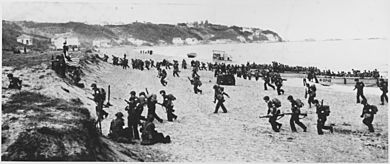
On November 8, 1942, the invasion began with landings on three beaches near Algiers. U.S. Major-General Charles W. Ryder was in overall command. British and U.S. troops landed. Even though some landings happened on the wrong beaches, it did not matter much because there was little French resistance. The French Resistance had already stopped all the coastal guns. One French commander even joined the Allies.
The only fighting happened in the port of Algiers. Two British destroyers tried to land U.S. Army Rangers directly onto the dock. They wanted to stop the French from destroying port facilities or sinking their ships. Heavy gunfire stopped one destroyer, but the other landed 250 Rangers before it was forced back to sea. The U.S. troops quickly moved inland. General Juin surrendered the city to the Allies at 6:00 PM.
What Happened Next
Political Outcomes

It quickly became clear that Giraud did not have the power to command the French forces. He preferred to wait in Gibraltar. However, Darlan in Algiers did have that power. Eisenhower, with support from Roosevelt and Churchill, made a deal with Darlan. They recognized Darlan as the French "High Commissioner" in North Africa. In return, Darlan ordered all French forces in North Africa to stop fighting the Allies and to cooperate. The deal was made on November 10, and French resistance stopped almost immediately.
The French troops in North Africa who were not captured joined the Allied forces. Soldiers from French North Africa later fought bravely for the Allies. They were part of the French Expeditionary Corps in the Italian campaign.
When Adolf Hitler found out about Darlan's deal, he immediately ordered the occupation of Vichy France. He also sent German troops to Tunisia. The American news media protested, calling it the "Darlan Deal." They pointed out that Roosevelt had made a deal with people who worked with Hitler. Eisenhower said he had no other choice if his forces were to move against the Germans and Italians in Tunisia.
Even though de Gaulle had no official power in Vichy North Africa, many people there now openly supported the Free French. This put pressure on Darlan. On December 24, Fernand Bonnier de La Chapelle, a French resistance fighter, killed Darlan. Bonnier de La Chapelle was arrested and executed two days later.
Giraud took over after Darlan. But like Darlan, he kept most of the old Vichy officials. He even ordered the arrest of the leaders of the Algiers takeover attempt.
The French North African government slowly became active in the Allied war effort. The few French troops in Tunisia did not fight the German troops arriving by air. Admiral Esteva, their commander, followed orders from Vichy. The Germans took the airfields there and brought in more troops. The French troops moved west. Within a few days, they started fighting the Germans, encouraged by small American and British groups. This showed that the French were committed to the Allied side. Later, all French forces were taken out of action and given proper new equipment by the Allies.
Giraud supported this but also wanted to keep the old Vichy government in North Africa. Under pressure from the Allies and de Gaulle's supporters, the French government changed. Vichy officials were slowly replaced, and their unfair rules were removed. In June 1943, Giraud and de Gaulle agreed to form the French Committee of National Liberation (CFLN). In November 1943, de Gaulle became the head of the CFLN. The U.S. and Britain then recognized him as the official head of the French government.
Another political result of Torch was that the Vichy government of French West Africa also joined the Allies.
Military Outcomes
Toulon
One of the agreements Germany made was that the southern part of France would remain free of German occupation. It would be governed by Vichy. But the Vichy French did not fight hard against the Allied invasions in North Africa. This, and de Gaulle's new policies, convinced the Germans that France could not be trusted. Also, the Allied presence in French North Africa meant Germany had no reason not to occupy all of France.
So, Germany and Italy immediately occupied southern France. The German Army moved to seize the French fleet in the port of Toulon starting November 10. If the Germans had captured these ships, their naval power in the Mediterranean would have greatly increased. But every important French ship was sunk by the French Navy at the dock before the Germans could take them.
Tunisia
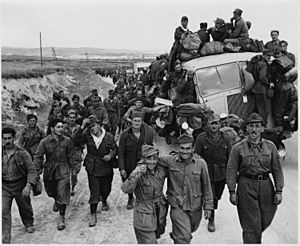
After Germany and Italy occupied Vichy France and failed to capture the French fleet, the French Army in Africa joined the Allies. They provided a third army corps for General Anderson. French warships, like the battleship Richelieu, also rejoined the Allies.
On November 9, German forces began to build up in French Tunisia. The local French forces, led by General Barré, did not stop them. Barré moved his troops into the hills and set up a defense line. He ordered that anyone trying to pass through would be shot. On November 19, the German commander demanded to pass through. The French refused. The Germans attacked the poorly equipped French units twice but were pushed back. The French had many casualties and lacked artillery and tanks, so Barré had to retreat.
After getting organized in Algeria, the Allies began the Tunisia Campaign. Parts of the First Army got within 40 miles of Tunis. But a German counterattack pushed them back. In January 1943, German and Italian troops, led by General Erwin Rommel, arrived in Tunisia. They were retreating west from Libya.
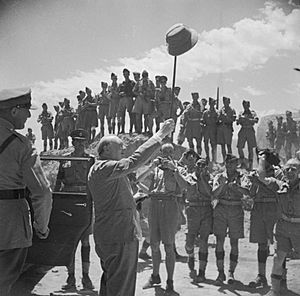
The Eighth Army was advancing from the east. They stopped near Tripoli while the port was repaired. This allowed more troops and supplies to arrive. In the west, the First Army was attacked in late January. They were forced back and suffered a defeat at the Battle of Sidi Bou Zid on February 14–15. German and Italian forces pushed on to Sbeitla. Then they fought the Battle of Kasserine Pass on February 19. The U.S. II Corps retreated in confusion until Allied reinforcements stopped the German advance on February 22. Fredendall was replaced by George Patton.
General Harold Alexander arrived in Tunisia in late February. He took charge of the new 18th Army Group. This group commanded the Eighth Army and the Allied forces already fighting in Tunisia. The German and Italian forces attacked eastward at the Battle of Medenine on March 6. But the Eighth Army easily pushed them back. Rommel wanted to retreat to a stronger defense line, but Hitler refused. On March 9, Rommel left Tunisia.
The problems at Kasserine forced the Allies to strengthen their forces. They also improved their supply lines before another attack. The First and Eighth Armies attacked again in April. There was hard fighting. But the Allies cut off the Germans and Italians from supplies by sea and air between Tunisia and Sicily. On May 6, the British took Tunis, and American forces reached Bizerte. By May 13, the German and Italian forces in Tunisia had surrendered. This opened the way for the Allied invasion of Sicily in July.
Later Impact
Operation Torch was very important in the war and a success for logistics. But it is often not given much attention in many popular histories of the war. The Economist suggested this is because French forces were the first enemies. This makes it harder to fit into the overall story of the war.
The operation was America's first military action in the Arab world since the Barbary Wars. According to The Economist, it helped set up America's policy in the Middle East after the war.
Images for kids


